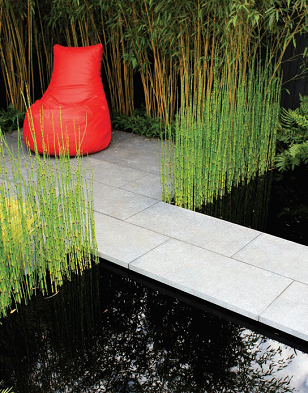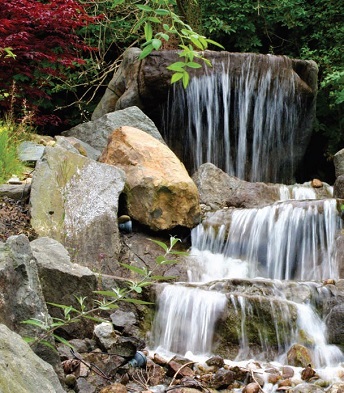Frazer McDonagh, one of Ireland’s leading water feature experts, explains why we all need to include water in our designs and provides some insight into getting it right
Water is an essential element for all great gardens. Big, small, traditional, avant-garde, historical, contemporary… no matter what style, context or intention – water creates a powerful effect.
Water and meaning
Water adds life to the garden and can greatly enhance a setting through movement, light, sound, and reflection. It has a compelling, mesmerising quality that draws the eye and it
adds a mood of tranquillity and relaxation. We are drawn to water as is all life. Insects, birds, frogs and everything else in between seek out water. To include it in a landscape affords an opportunity for us to connect with nature in a very natural way. Water is life.
Water can be used in many forms depending on the guiding style. It can resonate and mimic nature with cascading waterfalls and softened edges. It can be formal and accent
architecture and structure with hard, linear edges. It can be a focal element which helps to define style like a traditional fountain or modern water blade. Water can also set a tempo for a space from a still reflective plane, which evokes a sense of peace, to a heart rate raising flow over hard surfaces. The scale, speed, and context of water will greatly influence human response so care must be taken when designing it into a garden or landscape.
Factors to consider
The first things to factor in when considering the inclusion of water are the size of the space, the surrounding context, and overall style.
Formal gardens are best suited to water features with a geometric shaped pool or trough


with a water spout, blade or fountain. The use of geometry and structure allow for unity between elements. While the conflict between elements can create dynamism it is challenging to pull off well. In my experience, naturalistic gardens can accommodate both natural and formal features. The use of a more structured layout in a natural setting can – when done correctly – can make a bold statement, which accents the natural elements. Small gardens in suburban situations are best suited to formal ponds while larger rural landscapes suit more natural features. Think of it this way: when choosing the type of feature, consult with the surroundings and allow them to inform what will sit most comfortably.
Size matters
Water features should be treated in a similar way to other features in the garden with respect to size. I think most people are a little afraid of water and undersize their water elements. Often, as plants establish, the feature becomes crowded and hidden. Be brave and go bigger!
Location, location, location
Location is an important factor to consider. Avoid sitting a pond close to mature trees as roots can damage ponds, canopies can create too much shade and autumn leaf fall can result in a dirty looking pond and problems with pumps and filters. Construction might also
negatively impact tree health. Seek out a location where you can achieve a 50/50 balance between light and shade, which is best for plants and wildlife. The location should also be accessible. There is little point putting an element in a far off location where interaction will be limited.
Safety first
One of the most important issues in designing a water feature is safety. You need to know exactly who will have access to the water and what their capacity is. Children, animals, older people, people with disabilities and just your average person can all run into trouble with water. While it is impossible to design out all potential accidents great care must be taken to ensure appropriate steps are taken. Where there are real concerns it is worth considering the inclusion of a pond grid which sits just below the surface. Even if someone
fell in they wouldn’t drown. The above-noted safety concerns should not be a reason for excluding water.
Construction implications
There are several different methods of constructing water features and they all have merits and drawbacks. The three primary methods are using hard landscape materials and waterproof renders or sealers, hard landscape materials and waterproof liners, and finally puddled clay. The choice of method largely depends on the situation and desired outcome. Geometric shaped formal ponds are generally built with brick sides rendered, with a pond sealer applied. Liners are always challenging to use and unless you have a hard landscape edge – where the liner can be sandwiched and thus hidden from view – it will be tough to mask the interface between the water’s edge and surrounding soil. Naturalistic features and cascading waterfalls are the hardest water features to create. The key is to make them appear like they were always there. Anything less and they’ll look out of place and artificial.
Creating such features is as much an art as it is a science and I would advise anyone to bring in an expert unless you are very confident. My own confidence has come from years of working with water in all sorts of settings. I have spent hours studying natural features,
understanding how water flows and falls over rocks, how the flow shapes the rocks and vice versa. If you want to learn how to place rocks in features, get yourself into nature.
How deep is your love?
I love that water attracts life and you should too. Nothing complements water more than fish, plants, and wildlife. If you’re keen to maximise the potential diversity of a feature you’ve got to dig deep, both figuratively and physically. The greater the diversity of depths
or levels, the more life you can support. For instance, water lilies and water hawthorn need 60-90cm, while marginal plants sit comfortably in 20-30cm. Incorporating shelves to
facilitate plants is always worth considering. The shelves and levels provide unique habitats defined by light, oxygen, and temperature. A variety of plants will help to oxygenate the
water and create an equilibrium.
Maintenance and infrastructure
All water features require management input. It’s as simple as that. With a naturalistic feature, you are attempting to mimic nature and maintenance will usually centre on
encouraging the development of a balanced system and annual assessment. Plants often have to be thinned out every few years. They are only doing their thing, and if they’re
not managed they will eventually dominate and take over. I personally love to use Sagittaria latifolia – also known as arrowhead plant – as it’s an excellent water cleaning plant. Other species such as Scirpus spp. and Mentha aquatica, also do an excellent job.
In more formal settings it is vital to consider the use of filtering systems which are needed to limit algae, increase oxygen and stop water becoming stagnant. There are a number of internal and external filtering systems on the market, which work very well but also need regular cleaning. UV filter units clean water by zapping the algae particles but they also kill the small animal pond life so I prefer to keep water clean by using the right balance of plants that filter and clean the water along with moving water from a pump. Consideration also needs to be given to the location of the pond infrastructure. Ideally, nothing is visible. In my experience this where a lot of people fall down. If you are designing a pond, design inappropriate pump housing which is both accessible and discrete.
Water, they say, is the great leveller. No feature can add more atmosphere or cause more stress. Get it right and it’s magic, get it wrong and the results can be expensive, ugly, time-consuming and regret provoking. We all love water and should strive to include it where possible but if you’re not 100% confident you need to drop the idea or call in expert assistance. ✽

FRAZER McDONOGH is an award-winning water specialist and garden designer, perhaps best noted for his garden
creations at Bloom in the Park and numerous UK RHS shows.
He can be contacted at Tel: 087-225 8220 or via www.rockandwaterscapes.com






